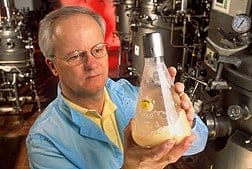Technological advances by U.S. Department of Agriculture (USDA) scientists are continuing to improve the way beneficial fungi are formulated for use as biopesticides.
Traditionally, biopesticide makers have cultured beneficial species of Beauveria, Isaria, Metarhizium and other fungi on moistened grains like rice or other solid substrates to coax them into forming specialized spores called “conidia.” These conidia are then harvested and formulated into biopesticide products, which can be applied to field- or greenhouse-grown crops as alternatives to synthetic pesticides or used in conjunction with them to delay the pests’ development of insecticide resistance.
Over the past decade, however, microbiologist Mark Jackson and colleagues at USDA’s Agricultural Research Service (ARS) have experimented with the use of liquid culture fermentation (LCF), an approach that’s enabled them to mass-produce stable, effective spore forms called “blastospores” and resting structures such as “microsclerotia.”
The researchers’ studies have shown that microsclerotia are especially durable, long-lasting during storage, and effective as bioinsecticides and bioherbicides. LCF has also proven to be faster and more economical to use, yielding blastospores or microsclerotia in two to three days versus the ten to fourteen days needed to produce conidia using the traditional culture methods, says Jackson. He is with the ARS National Center for Agricultural Utilization Research in Peoria, Illinois. Replacing hydrolyzed casein and other expensive nitrogen sources with low-cost cottonseed flour also reduces production media costs by 80-90 percent, he adds.
Jackson’s recent collaborations with visiting scientists Gabriel Mascarin (Brazilian Agricultural Research Corporation, a.k.a. “EMBRAPA”) and Nilce Kobori (National Council for Scientific and Technological Development) showed that LCF can also be a cost-effective way to produce spores of U.S. and Brazilian strains of Beauveria, Isaria, and Trichodermafungi.
In trials, the blastospores proved more effective than conidia generated by commercial production methods. For example, blastospores from LCF cultures of Beauveria killed silverleaf whitefly nymphs 25 percent faster than the conidia. Fewer blastospores were also required. Their studies also demonstrated, for the first time, that under appropriate LCF conditions,Trichoderma can form microsclerotia suitable for use as a seed coating or soil-incorporated granules to guard against plant diseases.
Read more about their findings in the April issue of AgResearch magazine. ARS is USDA’s principal intramural scientific research agency.


